14-17 May 2014. The Byzantine Empire, which lasted from 330 AD until the mid 1400’s, was a continuation of the eastern, and largely Greek-speaking Roman Empire. Cyprus became part of the Byzantine Empire in 395 AD and remained so for hundreds of years, except for a short period when the Arab Caliphates gained control. Then in 1192 Richard I of England captured the island, sold it to the Knights Templar who sold it to Guy de Lusignan of France whose descendants sold it to Venice and so on and so on. By 1571 it was part of the Ottoman, or Turkish Empire, and 1572 saw the beginning of twenty-eight violent uprisings during the next hundred years.
During Byzantine rule the Greek flavor of Cyprus and its people, which had been there since ancient times, solidified, and people followed the Greek, or Eastern Orthodox Church with the eventual establishment of the autonomous Church of Cyprus. There was probably some pressure from the Muslim Arab invaders to embrace Islam, and during both the French and Venetian rule there was pressure to follow Roman Catholicism.
There was always turmoil, especially in the coastal cities and towns, year after year for centuries. It’s no wonder that people took to the hills. And from the 11th to the 16th centuries in the rugged beautiful Troödos Mountains, the central massif of the island, they built their churches – tiny remote barn-like churches, some hidden in forests, some in tiny villages. These churches, still in use today, display some of the most exquisite Byzantine and post-Byzantine religious art ever produced, and ten of them collectively form a Unesco World Heritage Site.
Given its history one wonders if it is safe to visit Cyprus at all, but we are lucky enough to live in quiet times, so one sunny day in the middle of May we climb into our rented car and set out to explore the beguiling Troödos Mountains,
and to find the highly acclaimed painted churches of Cyprus.
The drive of a couple of hours is sweet and easy along winding mountain roads bringing us first to Metamorfosis tou Sotiros, or the church of the Transfiguration of the Saviour, dating from the early 1500’s. We are in awe. We’d read a little about these churches but really had no idea what they would be like. As happens so often when travelling, the real thing is often shocking, unexpected, and brilliant in a way you can’t imagine. From the outside Sotiros is an unassuming barn-like structure.
As we walk towards the entrance we almost bump into the priest.
And then we enter. It is a breathtaking moment. The one room is tiny but every surface is covered in murals and the gilded iconostasis shines luminously. We are not allowed to take photos, but here, and in some of the other churches we visit, I manage to convince the caretaker to let me take just one photo for my online journal. It looks so plain from the outside, but the stark contrast of the surprising beauty of the interior is a great, and joyous, jolt to the senses.
From Sotiros we travel further along the valley, and near the village of Lagoudera, we visit Panagia tou Araka. Araka was originally the church of a monastery and dates from 1192. Sotiros had astonished us, but it paled in comparison to Araka.
Most of these churches have an outside building with a steep roof built over the original church to protect them from the high snowfalls in the mountains. As with Sotiros, the outside was unassuming and barn-like.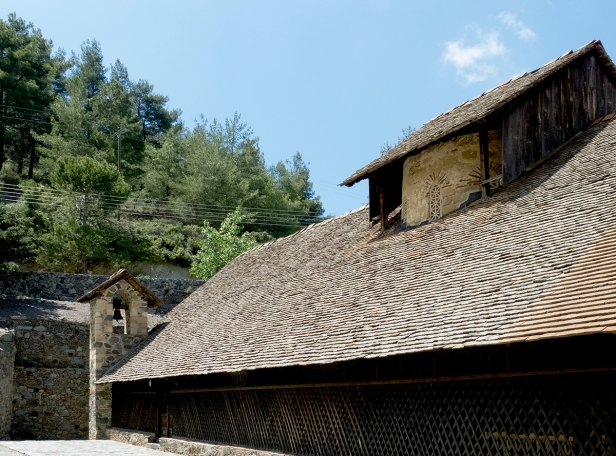
Once within the outer walls however we see the original frescoes and carvings on the outside walls of the inner building. They are over eight hundred years old.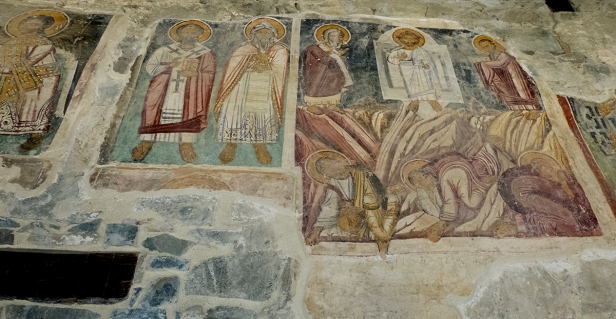

And then we walk into a completely restored interior.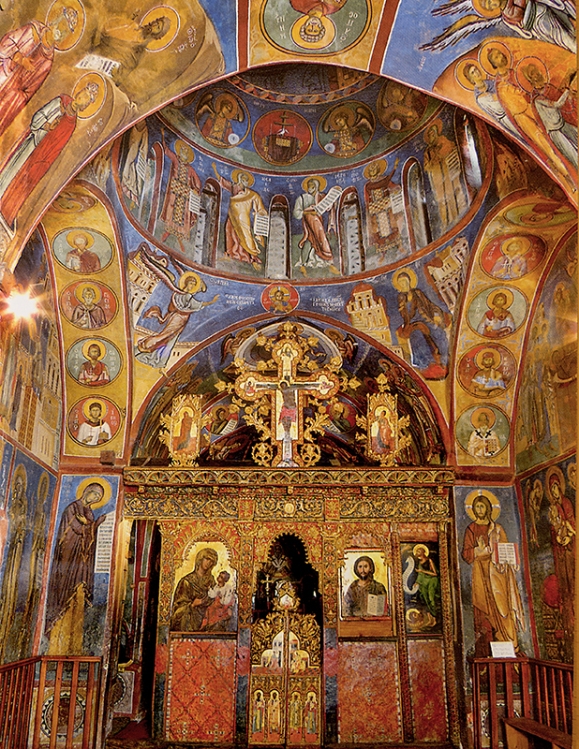
It’s a photograph of a postcard, and yet is still an accurate illustration of the glorious interior of this tiny church, and of the way all the Troödos churches must have looked when first completed. It’s hard to convey how tiny the spaces are, and how stunning their beauty.
Next morning, on the way to the village of Kakopetria, we encounter an abandoned village ablaze with flowers.
In Old Kakopetria along by the river we find enchanting Medieval streets, which we follow to the end and back, exploring all the nooks and crannies, sure that something new and wonderful is whispering to us from around every corner.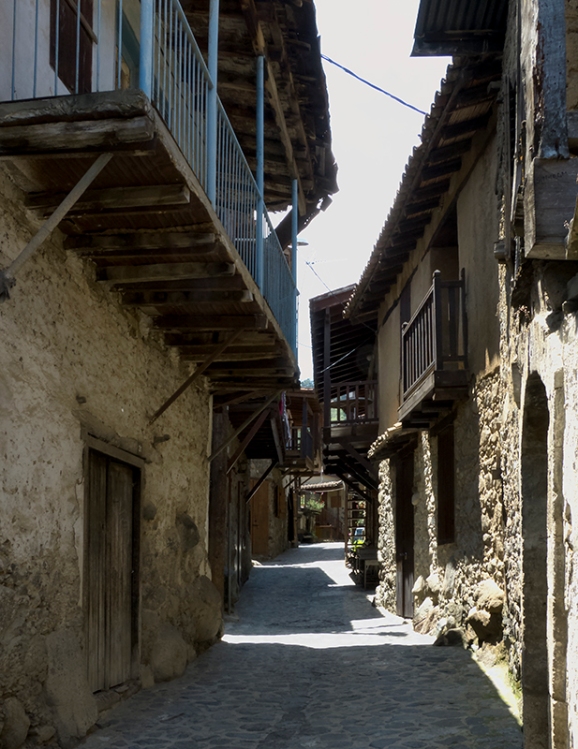

We discover the church. This is not one of the Unesco Byzantine churches, but is charming nonetheless, as is the delightful caretaker.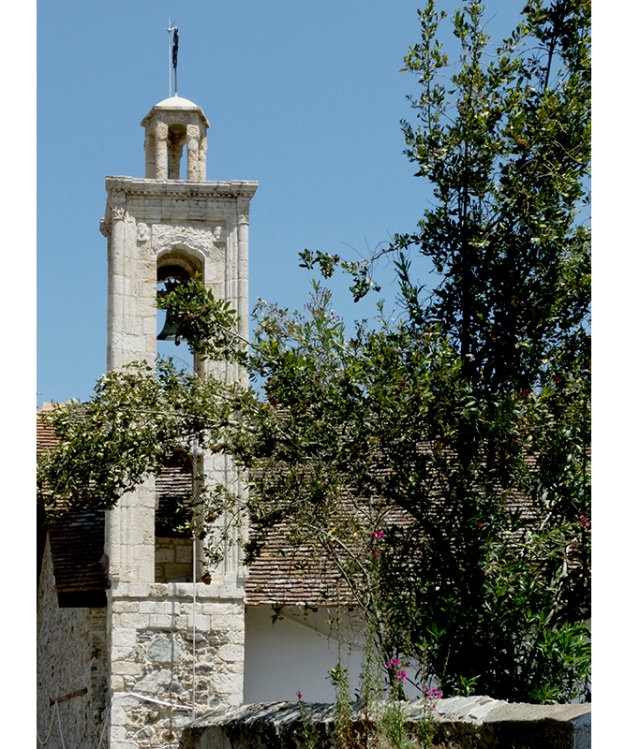
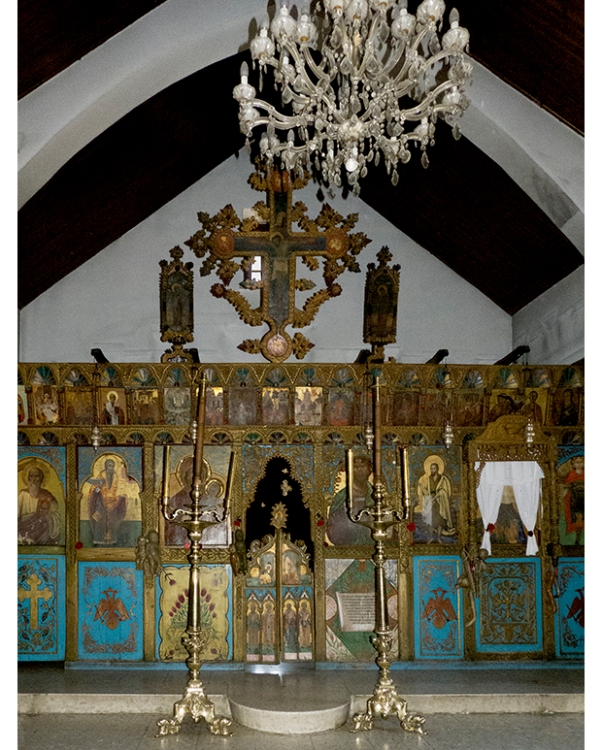

Just outside Kakopetria is Agios Nikolaos tis Stegis or the church of St Nicholas of the Roof, a reference to the upper roof of shingles built in the 15th century to protect the older domed roof of tiles. Agios Nicholaos tis Stegis is an 11th century monastery church.
The interior is covered in unrestored religious frescoes about 1000 years old. Imagine it as it would have been when new and as bright as the restored frescoes of Araka.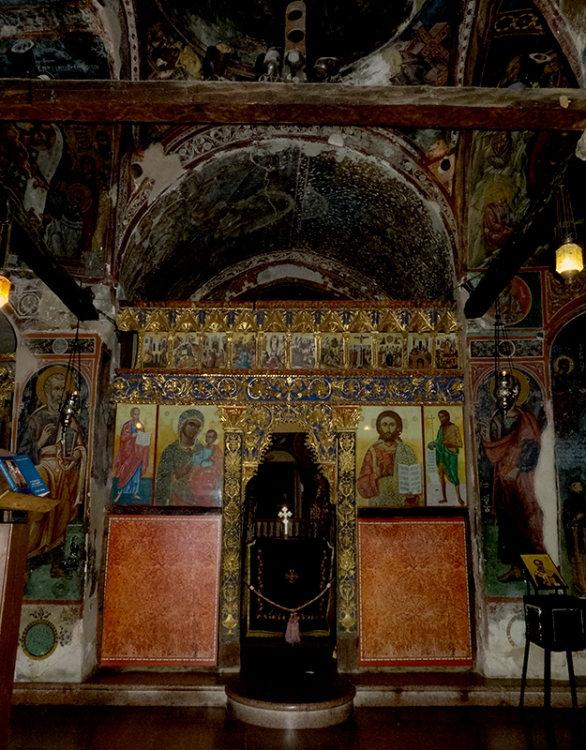
On the exterior wall we find a much younger decoration.
We hike one of the many trails on Mt Olympus, the highest in the Troödos massif, drive more winding mountain roads, and eat lunch at a sweet outdoor cafe covered in vines and flowers and perched on the edge of a cliff at the top of a steep village hill. The weather is glorious and the views spectacular.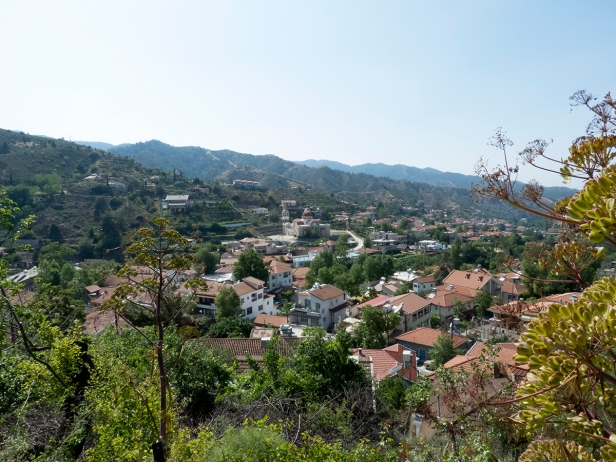

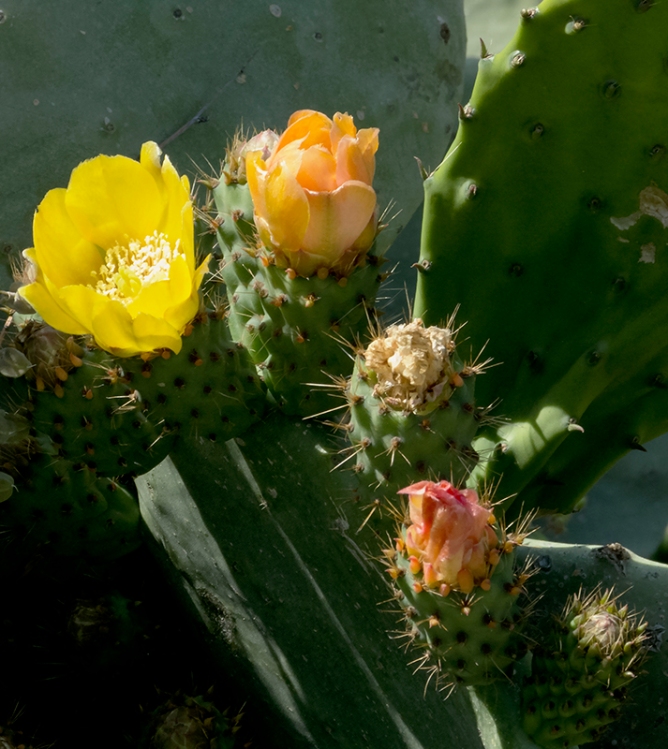
Pedoulas is known for its cherries but we are not there in cherry season. It was the beautiful 15th century Church of Archangel Michael that drew us there, and the sweet Byzantine museum with its fine collection of iconographic art. I love the religious art of this period. I’m not remotely religious but I love the cartoon-like style, the feeling of innocence, the unerring sense of design and colour, and the no doubt unintended impression of whimsy.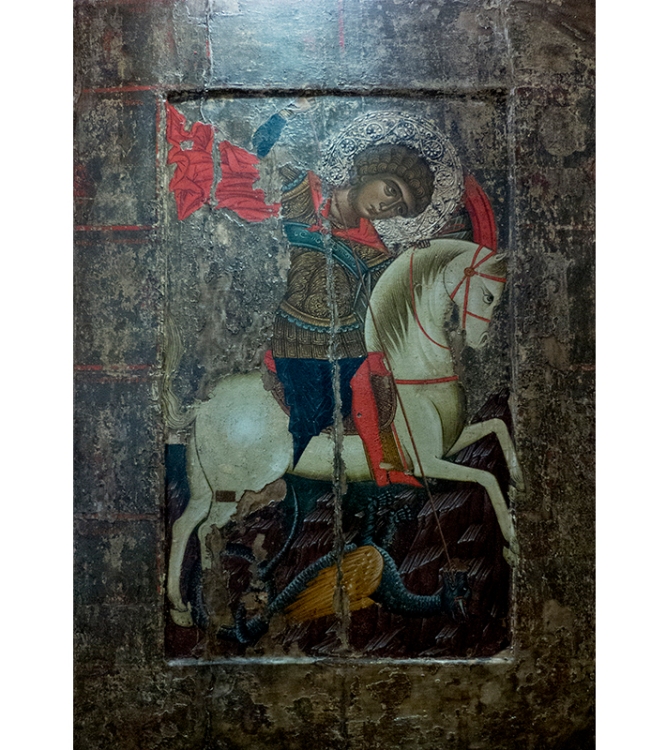



In the village of Kalopanagiotis, suspended along the side of the lush Setrachos Valley, we once again explore narrow winding cobble-stoned streets.
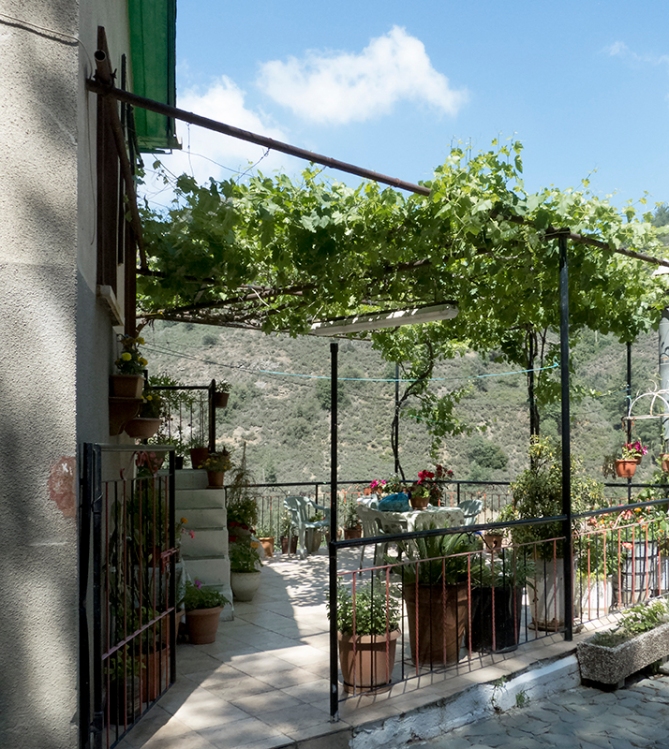
I wish I could say I had a lovely conversation with this woman sitting at her open doorway. We both tried really hard but she spoke not a word of English and I not a word of Greek.
Across the Setrachos River from the village is Agios Ioannis tou Lampadisti or the The Church and Monastery of Lampadistis. There are actually three adjoining churches in the same large space, side-by-side, each with it’s own nave, iconostasis and sanctuary, and little in the way of walls to divide them. One church is dedicated to Saint Herakleidios, and one commemorates John Lampadistis, a young monk who died there. His grave is thought to have healing powers. Two of the three churches are lavishly decorated with religious frescoes from the 11th to 15th centuries. Since 2009 students from London’s Courtauld Institute of Art have been restoring the frescoes. Once again we are astounded by the richness and beauty of it.
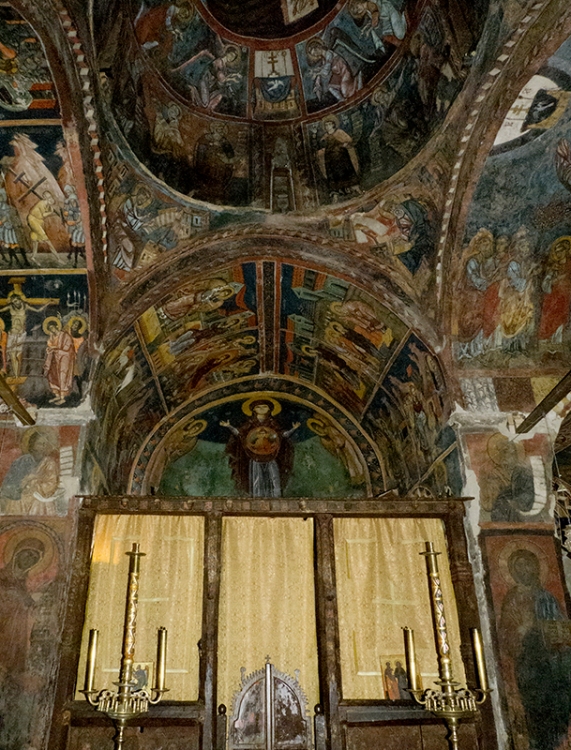
Detail of one of the panels, from a postcard
The courtyard of the monastery.
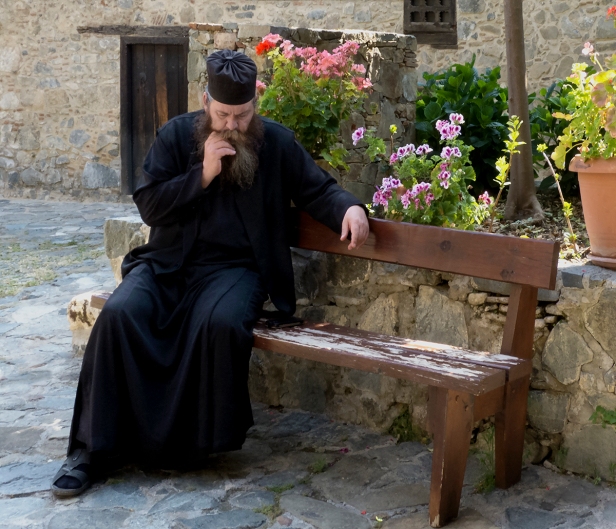
Wonderfully demonstrating the purpose of the frescoes as illustrations, or comic strips of the gospels for the illiterate, the Archangelos Michail church near the village of Galata, dating from 1514, reveals, panel by panel around its walls, the complete life of Christ. From a postcard, this is one of the panels: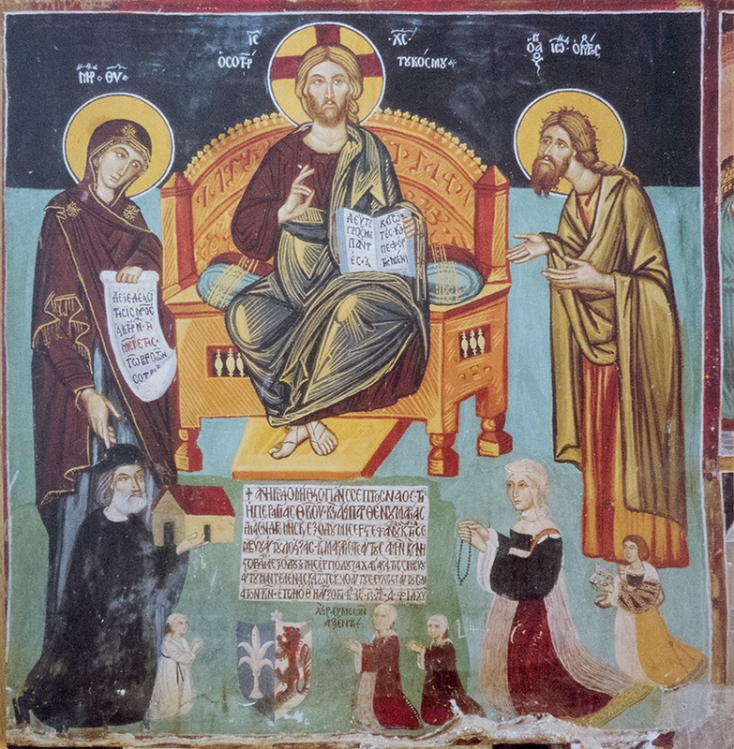
The church also faces a field of bright red poppies.
We fell in love with Troödos. After weeks of being unwell and doing very little, it felt good, exciting, to be on the road again, discovering new places, and having new experiences. We couldn’t have chosen better than a road trip through the glorious Troödos Mountains visiting the tiny painted churches of Cyprus.
Next post: from Troödos we drove to Paphos where we found a wealth of ruins from antiquity – Aphrodite’s birthplace, exquisite beautifully preserved Roman tile floors, and the grand Tombs of the Kings.
All words and images by Alison Louise Armstrong unless otherwise noted
© Alison Louise Armstrong and Adventures in Wonderland – a pilgrimage of the heart, 2010-2015.

Gorgeous!
LikeLike
Thanks Cindy. We loved both – the churches and the whole mountain region. Yes – gorgeous!
LikeLike
It’s wonderful to see these icons in situ, and the frescoes too of course. I have several books on Christian Iconography, and six beautiful icons depicting biblical scenes and figures, even though I’ve always been an Orthodox Buddhist! And yet the only time I’ve seen (pre)renaissance religious paintings in situ was on a trip to Venice. So, many thanks for this wonderful post Alison; it really is most a most spectacular one.
Hariod. ❤
LikeLike
Thanks Hariod, glad you enjoyed it. We were so completely captivated by the churches. Some were more spectacular than others of course, but the religious art of that period has such an innocent child-like quality. Don’t much like Renaissance art at all, never have. Way too serious for my taste 🙂
Alison
LikeLike
Wonderful to see the art work, all the detail and colors. Great photography and wonderful people shots. 🙂
LikeLike
Thanks Paulette. It turned out to be a more wonderful little road trip than we’d ever expected. The churches were so beautiful.
Alison xox
LikeLike
Beautiful architecture and art work!
LikeLike
Aren’t those churches gorgeous?! We were so glad we went to see them.
Alison
LikeLike
Thank you for this wonderful post. I have learned many important new things from your blog in just a few months. Like you, I am not religious but I do love ancient churches and their art. I feel that the creators and their sponsors speak to over the centuries by showing us what was most important to them.
Libbie Griffin
LikeLike
Thank you so much Libby, I’m so glad you’re enjoying our blog. I agree about religious/spiritual art speaking to us over the centuries, especially I think when the work is created from an authentic faith, as I believe these church paintings would have been. Perhaps that is one of the reasons we find it compelling. And it’s sheer beauty too of course!
Alison
LikeLike
As a graphic designer, I love this Byzantine religious art too — so colourful and celebratory. It belongs in the realm of folk art the world over, with its ritualistic forms and symbols. What wonderful discoveries you had in Cypress!
LikeLike
Isn’t the design just unerringly beautiful! I saw some absolutely gorgeous Romanesque religious art in the Museum of the art of Cataluña in Barcelona – exquisite design. And the Troödos churches were a wonderful discovery.
Alison
LikeLike
What a magical journey of discovery this road trip must have been! Thanks for taking us along and sharing these magnificent works of art and awe-inspiring churches. Anita
LikeLike
You’re welcome. Yes, you said it exactly – a magical journey of discovery. Better than we could have imagined.
Alison
LikeLike
What a wonderful way to get started again after being down for awhile. The frescoes are incredible, and the little villages are just ripe for exploration.
LikeLike
We were completely entranced from the first day to the last. And we never expected those churches to be so gorgeous, or the villages to be so charming. It was a great way to get moving again.
Alison
LikeLike
Beautiful architecture! But nothing beats the priest on his cell phone. Too cute for words.
LikeLike
Isn’t that a lucky shot?! I had to be really quick, and I’m amazed it’s in focus.
Really beautiful architecture. We loved it.
Alison
LikeLike
Alison, this is why we should get off the well-touristed path sometimes, to discover hidden gems like those churches and monasteries. Lovely images from a wonderful experience. I usually never take photos if I’m not allowed to, but maybe the next time I visit a place where I can’t take photos, I should do what you’ve been doing successfully. 🙂
LikeLike
I think we were lucky to be visiting in the off season. There were very few tourists around, but I’ve read that great busloads tour the area and are delivered to the ‘town’ of Troödos in the summer. The ‘town’ of Troödos is a hotel, a restaurant, and many souvenir stands.
I’ve found that asking for just one photograph for my journal usually works. We visited 6 of the 10 Unesco churches. Certainly in one of them I didn’t even ask, the caretaker was so grumpy. In anther he first said no and then relented.
I generally find the quality of postcards everywhere is pretty bad, but if that’s all that’s available it’s better than nothing. I do wish there had been more postcards that showed the whole interior like the one of Araka, rather than just individual panels, but Araka was the only place to have one like that.
I just followed you! Can’t believe I haven’t before this!
Alison
LikeLike
That sort of ‘town’ can be found in many places now, where tour buses drop a huge number of tourists eager to shop and eat. Not that I’m against it, but I personally would avoid visiting such place.
I find it very courteous of you to ask first before taking photographs. At Dolmabahce Palace in Istanbul people used to be able to take photos of the opulent interior. But one day some tourists used flash and the authority decided to not allow photography inside the palace for whatever reasons until now.
Ha, no worries! Looking forward to reading your posts on Indonesia one day. 🙂
LikeLike
I usually walk right past Byzantine iconic art in museums, but from now on, I will think of your cartoon style characters, whimsical faces, and brilliant blues and golds in your tiny mountain churches in Cypress and smile!
LikeLike
Aren’t they fun! And many are very beautiful with wonderful use of colour. Romanesque religious art also is very beautiful in the same child-like way. Don’t like Renaissance religious art at all – was too dark and heavy and serious. I’m delighted that you’ll look at the icons in a new way! The golden St George and the Dragon above is just wonderful – take a close look at the poor dragon 🙂
Alison
LikeLike
Beautiful! So excited to finally explore Cyprus through your eyes. 🙂
LikeLike
Thanks Felicity. Glad you’re enjoying Cyprus. It’s fun for us too – we get to enjoy it for a second time as I put the posts together. Troödos was really special.
Alison
LikeLike
I think it is hard to find any church more decorated than a Greek Orthodox Church. Peg and I stopped by several when wandering through the Greek Islands. It is also very hard to refrain from taking photos. 🙂 I suspect the ubiquitous nature of cell phones and their picture taking capabilities means lots of photos are taken. –Curt
LikeLike
Aren’t they stunning! Every church we went into, even the ‘ordinary’ (i.e. non-Unesco World Heritage) ones were ablaze with golden gorgeousness and begged to be photographed. I also suspect many cell phone photos are taken, though the Unesco churches are guarded quite closely, and I found very very few interior pics on the net.
Alison
LikeLike
I wonder whether it is a concern over sacredness or a concern over the impact of flashes, Alison? I’ve found a concern about flashes in several museums. -Curt
LikeLike
I’m think it’s a concern over the impact of the flashes. Maybe they don’t want to have to be policing it every minute so it’s easier to just ban photos outright. I know in Versailles they allow photos but no flash, but I have come across other churches where photos are banned outright in both Europe and South America so maybe it’s a bit of both.
LikeLike
Suspect so.
LikeLike
I’ve always been so curious about Cyprus and the photos you bring back make me want to go there even more.So much history ❤
LikeLike
Cyprus is quite wonderful, and yes, soooooo much history. About ten thousand years of it, and just about every empire wanted to control it. It’s really worth visiting. We didn’t get to the Turkish sector but have heard that it has the best beaches.
Alison
LikeLike
i find the history fascinating
and images, beautiful!
reminding me of visits
to Lesvos and Greek holidays.
LikeLike
Thank you so much. It was a wonderful exploration for us. I look forward to seeing Greece one day, but feel I got a tiny taste of it in Cyprus.
LikeLike
What an incredibly beautiful road trip! The sights, people, art and streets all have so much character.
Looking forward to the next leg – Aphrodite’s birthplace? Amazing!
~ Andrea ❤
LikeLike
It was a wonderful road trip, better than we imagined, especially the churches. Reading about them didn’t really prepare us for how beautiful they are. And the villages are just lovely.
Aphrodite coming up in a few days 🙂
Alison ❤
LikeLike
I know its a bit late – but I followed a FB thread from some old posts. I love your posts on Cyprus. It has been on my “list” for years. I particularly love the photo of the priest with the beard looking down with the flowers in the background. Beautiful image.
LikeLiked by 1 person
Thanks so much Helen. One of the Cyprus posts showed up on FB as a “memory” from 2 years ago so I reposted it. We spent two months in Cyprus, mainly recovering from mad travels around South America, but also exploring a little. I hope you get to Cyprus one day – it’s quite wonderful.
Alison
LikeLike
What a wonderful post Alison. The villages are as fascinating to me as the gorgeous churches. And the human element adds to the whole.
LikeLiked by 1 person
Thanks so much Madhu.We really enjoyed our travels in Cyprus, and the churches were definitely a sweet highlight.
Alison
LikeLike